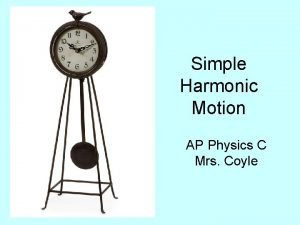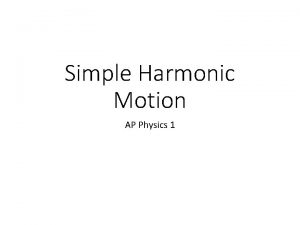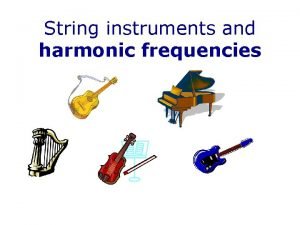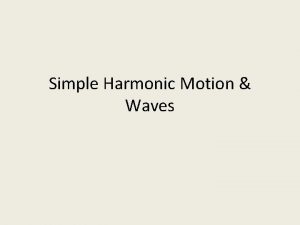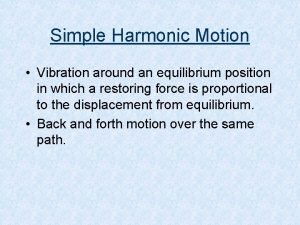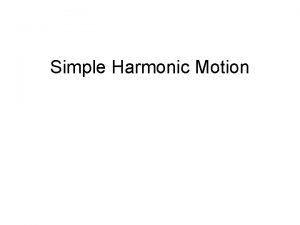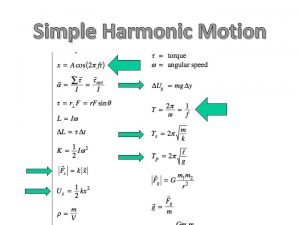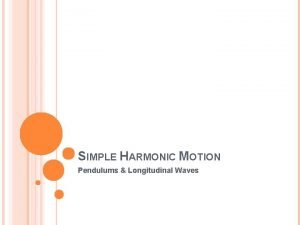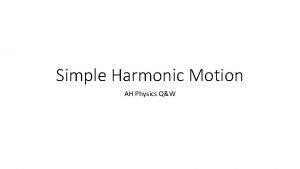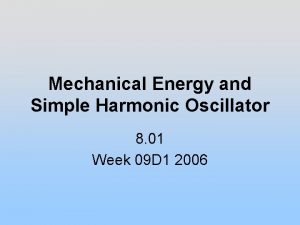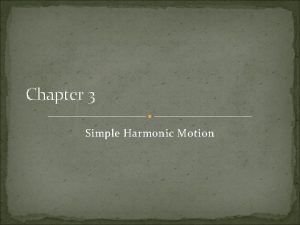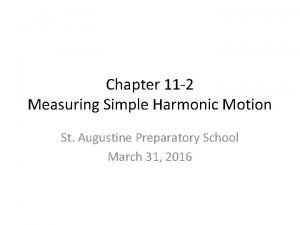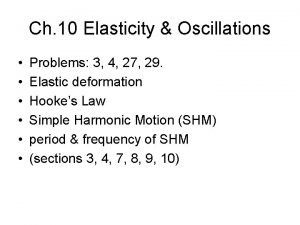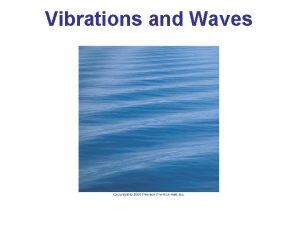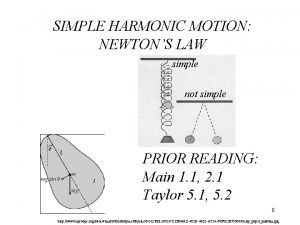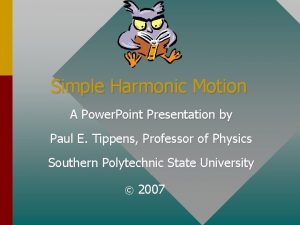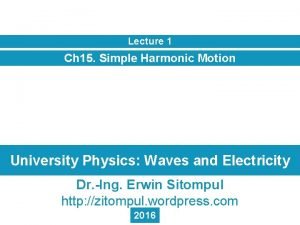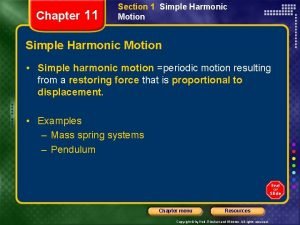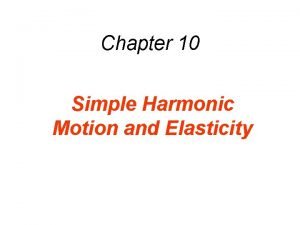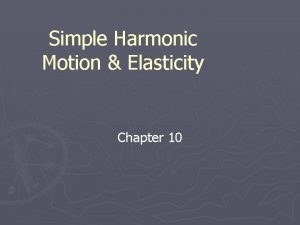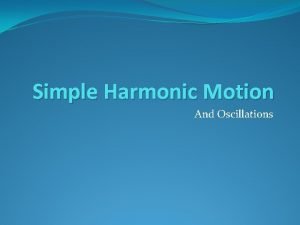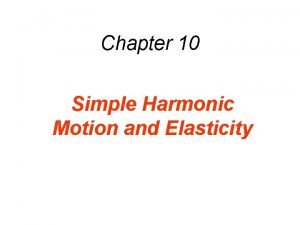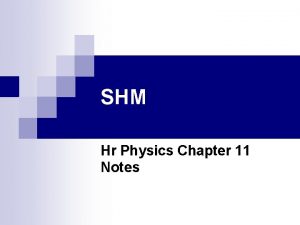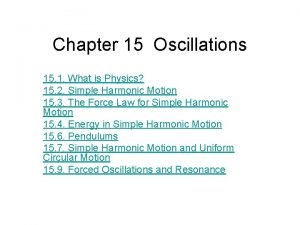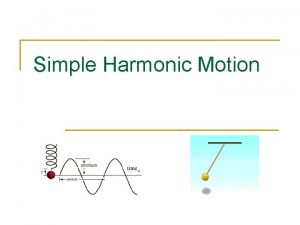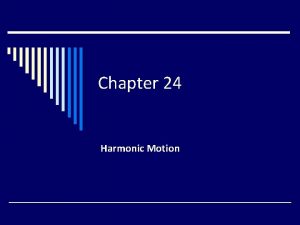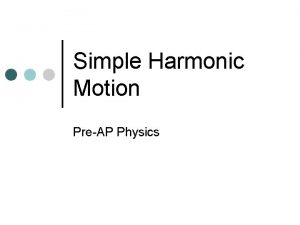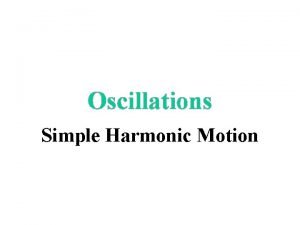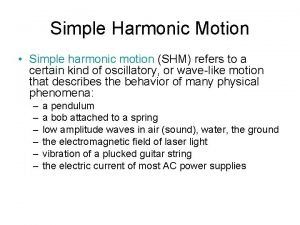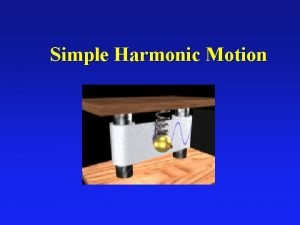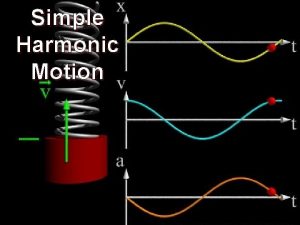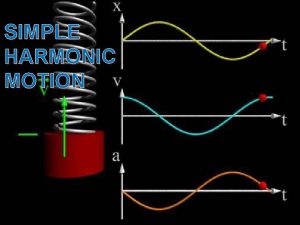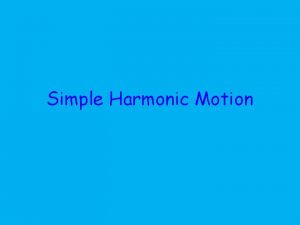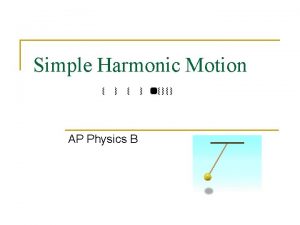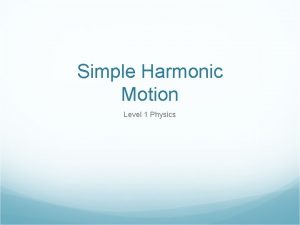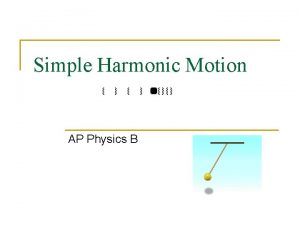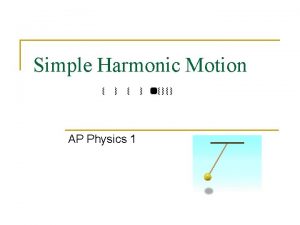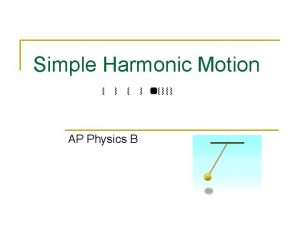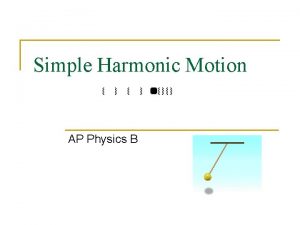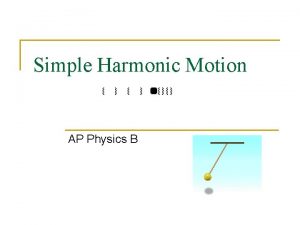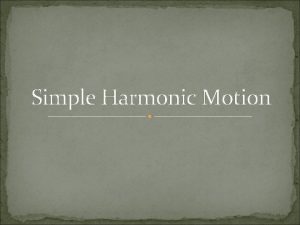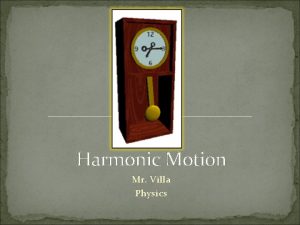Simple Harmonic Motion AP Physics 1 Simple Harmonic


























- Slides: 26

Simple Harmonic Motion AP Physics 1

Simple Harmonic Motion Back and forth motion that is caused by a force that is directly proportional to the displacement. The displacement centers around an equilibrium position.

Springs – Hooke’s Law One of the simplest type of simple harmonic motion is called Hooke's Law. This is primarily in reference to SPRINGS. The negative sign only tells us that “F” is what is called a RESTORING FORCE, in that it works in the OPPOSITE direction of the displacement.

Hooke’s Law Common formulas which are set equal to Hooke's law are N. S. L. and weight

Example A load of 50 N attached to a spring hanging vertically stretches the spring 5. 0 cm. The spring is now placed horizontally on a table and stretched 11. 0 cm. What force is required to stretch the spring this amount? 1000 N/m 110 N

Hooke’s Law from a Graphical Point of View Suppose we had the following data: x(m) Force(N) 0 0 0. 1 12 0. 2 24 0. 3 36 0. 4 48 0. 5 60 0. 6 72 k =120 N/m

We have seen F vs. x Before!!!! Work or ENERGY = FDx Since WORK or ENERGY is the AREA, we must get some type of energy when we compress or elongate the spring. This energy is the AREA under the line! Area = ELASTIC POTENTIAL ENERGY Since we STORE energy when the spring is compressed and elongated it classifies itself as a “type” of POTENTIAL ENERGY, Us. In this case, it is called ELASTIC POTENTIAL ENERGY.

Elastic Potential Energy The graph of F vs. x for a spring that is IDEAL in nature will always produce a line with a positive linear slope. Thus the area under the line will always be represented as a triangle. NOTE: Keep in mind that this can be applied to WORK or can be conserved with any other type of energy.

Example A slingshot consists of a light leather cup, containing a stone, that is pulled back against 2 rubber bands. It takes a force of 30 N to stretch the bands 1. 0 cm (a) What is the potential energy stored in the bands when a 50. 0 g stone is placed in the cup and pulled back 0. 20 m from the equilibrium position? (b) With what speed does it leave the slingshot? 3000 60 J 49 m/s N/m

Conservation of Energy in Springs

Springs are like Waves and The amplitude, A, of a wave is the Circles same as the displacement , x, of a CREST spring. Both are in meters. Equilibrium Line Trough Ts=sec/cycle. Let’s assume that the wave crosses the equilibrium line in one second intervals. T =3. 5 seconds/1. 75 cycles. T = 2 sec. Period, T, is the time for one revolution or in the case of springs the time for ONE COMPLETE oscillation (One crest and trough). Oscillations could also be called vibrations and cycles. In the wave above we have 1. 75 cycles or waves or vibrations or oscillations.

Frequency The FREQUENCY of a wave is the inverse of the PERIOD. That means that the frequency is the #cycles per sec. The commonly used unit is HERTZ(HZ).

SHM and Uniform Circular Motion Springs and Waves behave very similar to objects that move in circles. The radius of the circle is symbolic of the displacement, x, of a spring or the amplitude, A, of a wave.

SHM and Uniform Circular Motion • The radius of a circle is symbolic of the amplitude of a wave. • Energy is conserved as the elastic potential energy in a spring can be converted into kinetic energy. Once again the displacement of a spring is symbolic of the amplitude of a wave • Since BOTH algebraic expressions have the ratio of the Amplitude to the velocity we can set them equal to each other. • This derives the PERIOD of a SPRING.

Example A 200 g mass is attached to a spring and executes simple harmonic motion with a period of 0. 25 s If the total energy of the system is 2. 0 J, find the (a) force constant of the spring (b) the amplitude of the motion 126. 3 N/m 0. 18 m

Simple Harmonic Motion If we call the period of the motion T – this is the time to complete one full cycle – we can write the position as a function of time: It is then straightforward to show that the position at time t + T is the same as the position at time t, as we would expect.

Connections between Uniform Circular Motion and Simple Harmonic Motion Here, the object in circular motion has an angular speed of where T is the period of motion of the object in simple harmonic motion.

Connections between Uniform Circular Motion and Simple Harmonic Motion The position as a function of time: The angular frequency:

Pendulums, like springs, oscillate back and forth exhibiting simple harmonic behavior. A shadow projector would show a pendulum moving in synchronization with a circle. Here, the angular amplitude is equal to the radius of a circle.

Pendulums Consider the FBD for a pendulum. Here we have the weight and tension. Even though the weight isn’t at an angle let’s draw an axis along the tension. q q mgcosq mgsinq

Pendulums What is x? It is the amplitude! In the picture to the left, it represents the chord from where it was released to the bottom of the swing (equilibrium position).

Example A visitor to a lighthouse wishes to determine the height of the tower. She ties a spool of thread to a small rock to make a simple pendulum, which she hangs down the center of a spiral staircase of the tower. The period of oscillation is 9. 40 s. What is the height of the tower? L = Height = 21. 93 m

When a family of four with a total mass of 200 kg step into their 1200 kg car, the car’s springs compress 3. 0 cm. What is the spring constant of the car’s springs, assuming they act as a single spring? How far will the car lower if loaded with 300 kg?

Does a car bounce faster on its springs when empty or fully loaded?

Damped Harmonic Motion Damped harmonic motion is harmonic motion with a frictional or drag force. If the damping is small, we can treat it as an “envelope” that modifies the undamped oscillation.

Damped Harmonic Motion There are systems where damping is unwanted, such as clocks and watches. Then there are systems in which it is wanted, and often needs to be as close to critical damping as possible, such as automobile shock absorbers and earthquake protection for buildings. Overdamped – returns to equilibrium slower than the normal restoring force would allow without oscillating Critically damped – returns to equilibrium at a normal rate but and does not oscillate. Underdamped – the system oscillates until with decreasing amplitude until it reaches equilibrium.
 Harmonic motion examples
Harmonic motion examples Ap physics 1 simple harmonic motion
Ap physics 1 simple harmonic motion Simple harmonic motion formula sheet
Simple harmonic motion formula sheet Wave
Wave Simple harmonic motion vocabulary
Simple harmonic motion vocabulary Simple harmonic motion equilibrium position
Simple harmonic motion equilibrium position Spring constant formula
Spring constant formula Reference circle simple harmonic motion
Reference circle simple harmonic motion What unit is period measured in
What unit is period measured in Period of simple harmonic motion
Period of simple harmonic motion Dimension of simple harmonic motion
Dimension of simple harmonic motion Mechanical energy
Mechanical energy Harmonic motion equation
Harmonic motion equation A 125 n object vibrates
A 125 n object vibrates Frequency of shm formula
Frequency of shm formula Simple harmonic motion formula
Simple harmonic motion formula Energy of simple pendulum
Energy of simple pendulum Simple harmonic motion presentation
Simple harmonic motion presentation Slidetodoc
Slidetodoc Simple harmonic motion chapter 11
Simple harmonic motion chapter 11 Simple harmonic motion and elasticity
Simple harmonic motion and elasticity Simple harmonic motion and elasticity
Simple harmonic motion and elasticity Kinematics of simple harmonic motion
Kinematics of simple harmonic motion Damped oscillation
Damped oscillation A trapeze artist swings in simple harmonic
A trapeze artist swings in simple harmonic Maximum excursion from equilibrium
Maximum excursion from equilibrium What is simple harmonic motion
What is simple harmonic motion
